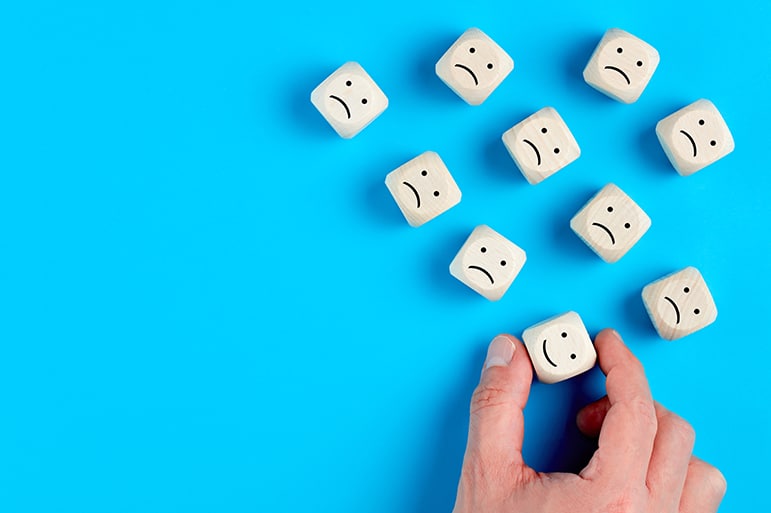Think of a time during which you felt unhappy for a sustained period of time, be it a day, week, month, year, or longer. When I use the word unhappy, I mean to be inclusive; perhaps you felt sad, depressed, anxious, anergic, hopeless, stressed, or overwhelmed – name your version of unhappiness.
Today I discuss what sustains periods of unhappiness and what can disrupt its self-sustaining nature. Given this understanding, we then can make changes intentionally to return to a normally fluid existence of appropriately and flexibly changing moods, thoughts, and behaviors.
Consider this: why did your period of unhappiness, even if it was only for a single day, continue for as long as it did? Even one day is made of thousands of moments. Why did each moment progress to the next one and still your unhappiness continued?
I submit to you it is because unhappiness (just like happiness) has a self-sustaining structure. Consider the aspects of the complex organism that is you. To keep this simple, let’s use the biopsychosocial model of function. First, underlying it all is your biology, that is your entire body including your brain. Your psychological functions are based on the brain’s functions, especially (but not only) the conscious aspects of the mind. These can be categorized as drives/desires/cravings, attention, perceptions, cognitions, emotions, and behavior. And, since we are embedded into our environment, especially in relationship to other human beings, we also can isolate and focus on the social aspects of our function.
All these aspects of an organism can form self-sustaining relationships among themselves that maintain that particular state of the organism. Thus, unhappiness can beget unhappiness while happiness can beget happiness.
When a person is feeling depressed, for instance, they may spend an inordinate amount of time on depressogenic thoughts that reinforce depressogenic beliefs, that are supported by attending to stimuli (that seem particularly salient at that time), and that support a depressive view of the self and world. That person is then likely to act in ways that decrease their sense of pleasure, meaning, purpose, and self-esteem. Further, all this may be associated (in a circular and self-reinforcing way) with changes in the underlying biology. Elevated stress hormones can interfere with sleep, alter food intake, lead to “sickness behaviors,” and interfere with the brain’s — especially the frontal lobes’ — problem-solving abilities.
In addition to all these biological and psychological aspects, social interactions also may support the continuation of depressive symptoms: the person may be emotionally unavailable to others, isolated from them, and rude or abusive toward them. They, in turn, move away from the depressed person who descends further into isolation and disruption of their close relationships.
OK, now what? Once here in a state of multi-faceted depression, what happens next? Often it is a continuation of what is happening presently. Many of these biopsychosocial aspects sustain the ongoing depressed state.
But eventually, most people with unhappiness born from the trials and tribulations of life (as well as those with clinical depression) do recover. Eventually, something changes enough to disrupt this self-sustaining state of unhappiness or frank depression. Sometimes the change happens unplanned: something changes in the person’s life circumstances that they did not initiate themselves. Sometimes, the change is initiated intentionally by the depressed person, whether or not it is part of a formal mental health treatment.
Within mental health treatment, for some people with clinical depression, the biology may be targeted directly through the use of antidepressants or neurostimulation treatments such as transcranial magnetic stimulation or deep brain stimulation, for example. For persons with milder forms of depression, psychotherapies can target different aspects of psychosocial function to effect change. There are now hundreds of different forms of psychotherapy – true! – that fit into several different major theoretical schools. Psychotherapies can specifically target attention, cognition, emotion, or behavior to variable degrees.
Despite the great differences in which aspects of psychosocial function different psychotherapies target, they have been found to all work about equally well across several different types of psychiatric disorders, such as depression, anxiety disorders, trauma-related disorders, and addictions. (Interestingly, all anti-depressants have similar overall response rates too.)
What are the lessons from the fact that so many different treatment approaches work equally well? Whether of clinical severity or not, unhappiness is formed through mutually reinforcing relationships among the different aspects of our biology and psychosocial functions. Maybe the underlying mechanism of change is simply one of causing sufficient disruption to the current state of the individual. Disruption can be achieved through disrupting any factor within the system of interrelated functions.
What are the implications for resolving a sustained period of unhappiness (or even clinical depression)? Do something — anything — different! You’ve probably heard the saying, “The definition of neurosis (or insanity) is doing the same things and hoping for a different result.” This seems like a trite, virtually meaningless pop psychological aphorism. I submit to you, however, that there is deep wisdom here and, if this saying’s implicit dictum is followed, it is the key to overcoming various forms of unhappiness and dysfunction. If doing the same things leads to the same results, then doing something different will lead, or at least has the potential to lead, to different results. So, if you’re happy, keep doing what you’re doing. If you’re unhappy, do something different.
I will leave you with a few really simple and fast ways of disrupting your periods of unhappiness below.
Fast and Simple Changes
Cognitive Diffusion Techniques: If you have some negative thought stuck in your head, you can distance yourself from it (without directly arguing against its content) in the following ways. You can repeat your negative thought as fast as you can for about 30 seconds. Soon, the meaning behind it will dissolve, and you’ll be left with the sounds only. Or you can add circus music behind your internal monologue to make it sound ridiculous. Or you can say your negative thoughts in the voice of your favorite cartoon character. Or you can pretend your thought is on the radio and you can turn the volume up or turn it off (use caution turning down the volume – the thought will remain doing its damage while being even harder to notice).
Mindfulness Techniques: Pay attention to the present moment. For example, if you’re taking a walk, attend to stimuli from your different senses. What do you hear? What do you smell? What do you see? Do you notice, perhaps, that you often walk with your head down? If so, it’s an indication you’re probably preoccupied with thoughts. So look up! Look to see what people passing you are wearing. Notice their expressions. Where are they looking? You’ll be amazed how many people also walk looking down and thinking – planning, making lists, worrying – over and over again. Or look up at the trees or the sky. You’ll be surprised how much better you can feel — virtually instantly.
Behavioral Activation: When you have a moment of free time at work, move! I’ve written before that I’ve calculated that I can walk about half a mile in ten minutes. Imagine you take 10 minutes from your lunch time or after work to take a brisk walk – while you mindfully attend to your senses. If you can’t afford to take 10 minutes from your day, then that may indicate other life issues to consider. I’ll touch on that in future posts.
Change of Perspective: All the above fast and simple exercises are likely to change your perspective — which may be enough to disrupt a sustaining period of unhappiness. I employ a technique of separating my observing self from my body and observing my physical being as well as my thoughts and emotions from the outside. I find this technique particularly effective in disrupting unwanted trains of thought and mood states.
Now it’s Your Turn!
If you don’t take action, triggered by what I write or just by being reminded more generally that change is possible, then nothing changes. As another saying goes, “Nothing changes until something moves.” In this case that “something” is you.
Let me know how it’s going and what else I can help you with.
Until next time,
Dr. Jack
LanguageBrief
“Yesterday I was clever, so I wanted to change the world. Today I am wise, so I am changing myself.” – Jalaluddin Rumi
“Our lives are lived in intense and anxious struggle, in a swirl of speed and aggression, in competing, grasping, possessing and achieving, forever burdening ourselves with extraneous activities and preoccupations.” – Sogyal Rinpoche
“Knowing others is intelligence; knowing yourself is true wisdom. Mastering others is strength; mastering yourself is true power.” – Lao Tzu“Be the change that you wish to see in the world.” – Mahatma Gandhi







Leave A Comment